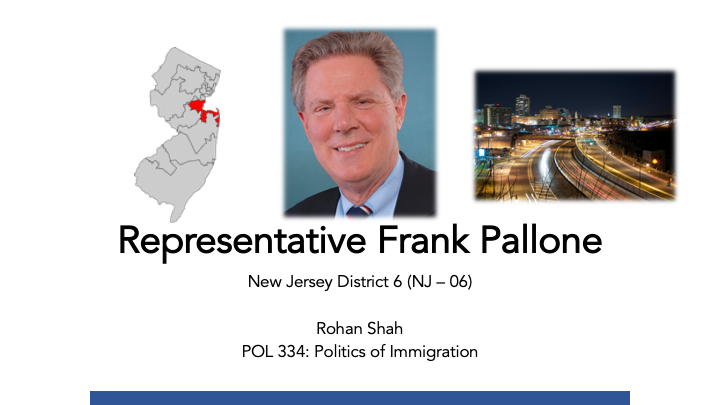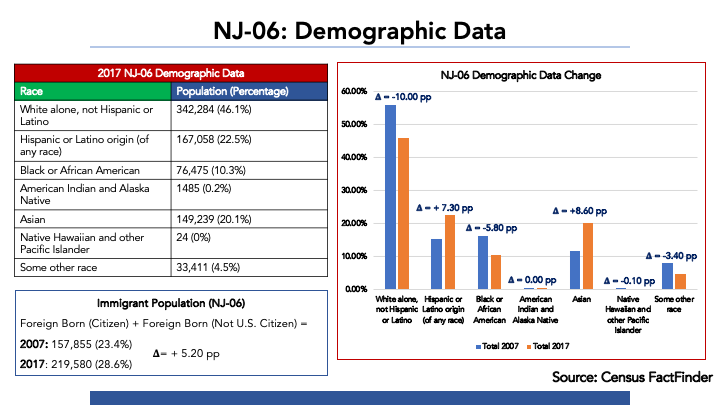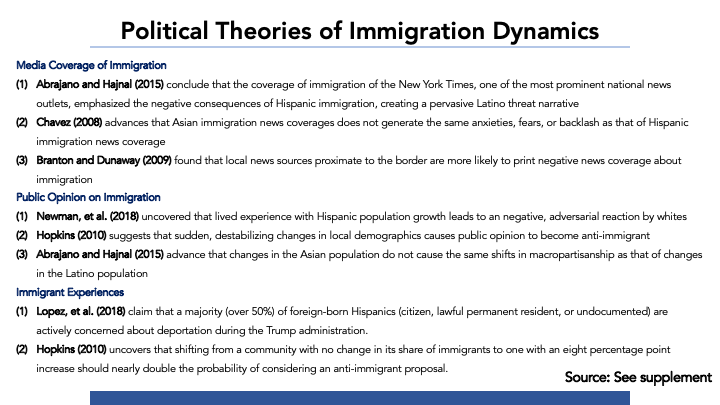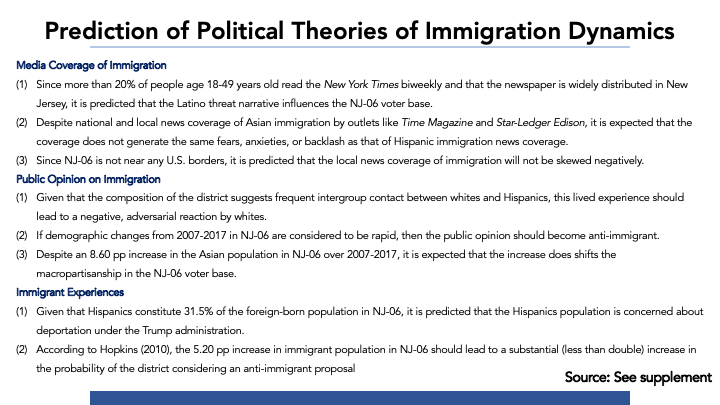
Representative: Frank Pallone
Congressional District: 6th District of New Jersey
Party: Democratic Party
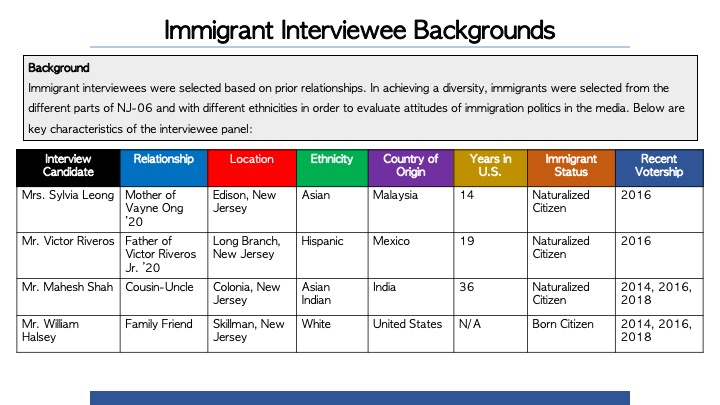
Immigrant Interviewee Backgrounds
As described previously in Assignment 2, a qualitative interview study was designed to evaluate how attitudes differ to news coverage of Latino versus Asian immigration. A diverse panel of immigrants were interviewed from across the district. Mrs. Sylvia Leong and Mr. Mahesh Shah represented Asian immigrants and were from the Asian population center of the district. Both interviewees, however, had different backgrounds with Mr. Shah being actively involved in local politics. Mrs. Leong, on the other hand, demonstrated little interest in news media and immigration politics. Mr. Victor Riveros represented the Latino voice and was also from a Latino population center. Mr. Riveros held strong views on the media treatment of Latino immigrants but not of Asian immigrants. Mr. William Halsey represented Non-Hispanic white Americans; he actively followed local and national news media but had neutral views on immigration.

Interview Script Description
In order to evaluate immigrant attitudes, the qualitative interview study was designed with a line of questioning that first gauged exposure and broad views before drilling down. The same line of questioning was used for every interview irrespective of ethnicity to maintain consistency. Each interview began with questions assessing exposure to local and national news, followed by evaluation if those news sources were fair and balanced in respect to politics and immigration. Next, the questioning would address opinion on the Latino and Asian ethnic groups, highlighting their work ethic and impact on American culture. Lastly, the questioning would strike at the heart of the matter, evaluating how immigration news coverage was perceived and affected political affiliation.
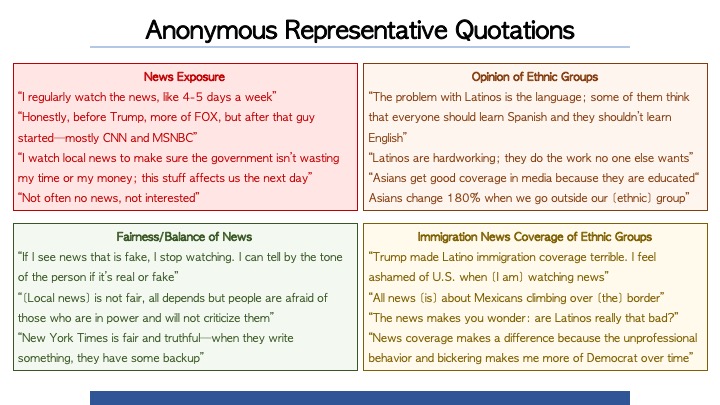
Anonymous Representative Quotations
All interviewees requested that the interview content remain anonymous. In accordance with the line of questioning, the quotations from the interviews did hit on all the major themes of news exposure, fairness/balance of news, opinion of ethnic groups, and immigration news coverage of ethnic groups. There was a high degree of variability in respect to news exposure with some interviewees following both local and national news regularly and others having little interest in either source. Many of the interviewees struggled to evaluate the fairness and balance of their news sources, alluding to news sources like FOX or CNN to illustrate bias. Importantly, all of the interviewees believed that local news was also biased and dominated by special interests. On the opinion of ethnic groups, the ethnicity of the interviewee played a major factor as expected. In general, Latino immigrants were perceived to be hardworking but unassimilated due to language and cultural barriers. On the other hand, Asians were deemed to be a model minority and integrated members of American society. Questions pertaining to immigration news coverage tended to elicit the most opinionated and vibrant responses. News coverage of immigration was vehemently criticized and, in many cases, equated coverage with the sentiments and words of President Trump. Although the interviews did achieved the diversity in thought, the disparity in understanding and language barrier did impact the findings.
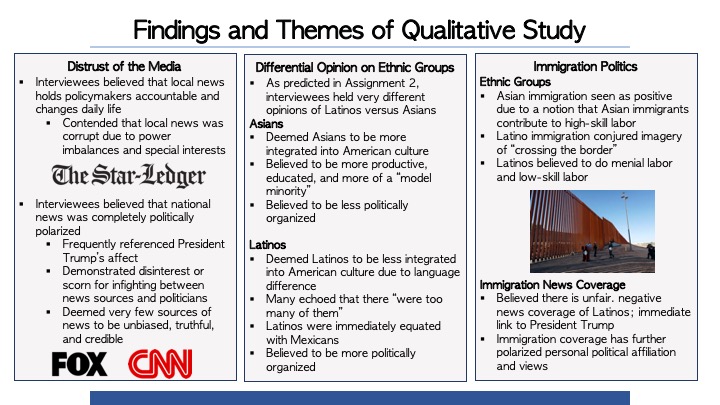
Findings and Themes of Qualitative Study
The qualitative interview study did confirm the original hypothesis and reveal interesting sentiments around immigration politics in the media. Significantly, all the interviewees demonstrated a clear mistrust of the media at both the local and national levels. Many struggled to spotlight an unbiased and credible news source. I speculate that these results would be very different a few years ago. The emergence of social media, “fake news”, and media overload has perhaps caused everyday people to lose faith in the media. Without being prompted, many respondents also tied their distrust of the media to President Trump. As expected, there was also a clear difference in perception of Asian immigration versus Latino immigration. Asians were in general deemed to be more integrated and productive. As a result, Asian immigration was referenced positively by respondents. Latinos, in contrast, were generally believed to occupy a lower standing and be less integrated into society due to the language barrier. Although Latino immigrants were thought to be industrious, Latino immigration was also negatively associated with “crossing the border” and the border wall. Importantly, the immigration coverage of Asians and Latinos was thought to be unfair and attacking. The climate around immigration news coverage prompted many to retrench deeper into their personal political views and affiliations.
